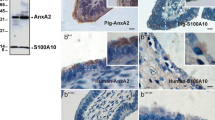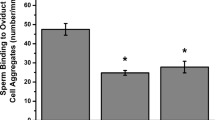Abstract
In several mammals a sperm reservoir is formed at the isthmus of the Fallopian tube, providing viable, potentially fertile sperm for an extensive period. In pig (Sus scrofa) the spermadhesin AQN-1 seems to be involved in the establishment of the sperm reservoir. The pig oviductal protein, sperm binding glycoprotein (SBG), binds to sperm and exposes carbohydrate groups that can be recognized by AQN-1. In this study we obtain anti-SBG polyclonal antibodies and use them to localize SBG in the oviduct. Immunohistochemical analysis shows that SBG is present at the apical surface of isthmic and ampullar epithelial cells. The presence of SBG is limited to the upper two-thirds of the crypts of the isthmus and to cells located near the oviductal lumen in the ampulla. The ratio of the amount of SBG detected by western blot is 1:3 (ampulla:isthmus). Sperm entering the Fallopian tube probably contact the epithelial cells at the lumen before they reach the cells at the bottom of the folds. In vitro sperm can bind to isthmus and, at less extent, to ampulla. Thus, the localization and the relative amount of SBG in the isthmus and ampulla of pig’s oviduct are compatible with its possible function in sperm binding to oviductal epithelial cells.



Similar content being viewed by others
References
Baillie HS, Pacey AA, Warren MA, Scudamore IW, Barrat CLR (1997) Greater numbers of human spermatozoa associate with endosalpingeal cells derived from the isthmus compared with those from the ampulla. Hum Reprod 12:1985–1992
Calvete JJ, Carrera E, Sanz L, Töpfer-Petersen E (1996) Boar spermadhesins AQN-1 and AQN-3: oligosaccharide and zona pellucida binding characteristics. Biol Chem 377:521–527
Dostalova Z, Calvete JJ, Sanz L, Töpfer-Petersen E (1995) Boar spermadhesin AWN-1. Oligosaccharide and zona pellucida binding characteristics. Eur J Biochem 230:329–336
Ekhlasi-Hundrieser M, Gohr K, Wagner A, Tsolova M, Petrunkina A, Töpfer-Petersen E (2005) Spermadhesin AQN1 is a candidate receptor molecule involved in the formation of the oviductal sperm reservoir in pig. Biol Reprod 73(3):536–545
Fazeli A, Duncan AE, Watson PF, Holt VW (1999) Sperm–oviduct interaction: induction of capacitation and preferential binding of uncapacitated spermatozoa to oviductal epithelial cells in porcine species. Biol Reprod 60:869–886
Green C, Bredl J, Holt W, Watson P, Fazeli A (2001) Carbohydrate mediation of boar sperm binding to oviductal epithelial cells in vitro. Reproduction 122:305–315
Gualtieri R, Talevi R (2000) In vitro cultured bovine oviductal cells bind acrosome-intact sperm and retain this ability upon sperm release. Biol Reprod 62:1754–1762
Gwathmey TYM, Ignotz GG, Suarez SS (2003) PDC-109 (BSP-A1/A2) promotes bull sperm binding to oviductal epithelium in vitro and may be involved in forming the oviductal sperm reservoir. Biol Reprod 69:809–815
Harlow E, Lane D (1998) Antibodies, a laboratory manual. Cold Spring Harbor Laboratory, Cold Spring Harbor, pp 53–135, 310
Harper MJF (1994) Gamete and zygote transport. In: Knobil E, Neill JD (eds) The physiology of reproduction, 2nd edn. Raven Press, New York, pp 123–187
Hunter RHF (1981) Sperm transport and reservoirs in the pig oviduct in relation to the time of ovulation. J Reprod Fertil 63:109–117
Hunter RHF (1988) Transport of gametes, selection of spermatozoa and gamete lifespans in the female tracts. In: Hunter RHF (ed) The Fallopian tubes. Springer, Berlin Heidelberg New York, pp 53–80
Hunter RHF (1995) Ovarian endocrine control of sperm progression in the Fallopian tubes. Oxf Rev Reprod Biol 17:85–124
Hunter RHF, Nichol R (1983) Transport of spermatozoa in the sheep oviduct: preovulatory sequestering of cells in the caudal isthmus. J Exp Zool 228:121–128
Hunter RHF, Flechon B, Flechon JE (1991) Distribution, morphology and epithelial interactions of bovine spermatozoa in the oviduct before and after ovulation: a scanning electron microscopy study. Tissue Cell 23:641–656
Laemmli UK (1970) Cleavage of structural proteins during the assembly of the head of bacteriophage T4. Nature 227:680–685
Lefebvre R, Chenoweth P, Drost M, LeClear C, MacCubbin M, Dutton J, Suarez S (1995) Characterization of the oviductal sperm reservoir in cattle. Biol Reprod 53:1066–1074
Lowry OH, Rosebrough NJ, Farr AL, Randall RJ (1951) Protein measurement with the Folin phenol reagent. J Biol Chem 193:265–275
Marini PE, Cabada MO (2003) One step purification and biochemical characterization of a spermatozoa-binding protein from porcine oviductal epithelial cells. Mol Reprod Dev 66:383–390
Murray SC, Smith TT (1997) Sperm interaction with Fallopian tube apical membrane enhances sperm motility and delays capacitation. Fertil Steril 68:351–357
Raychoudhury S, Suarez S, Buhi W (1993) Distribution of lectin binding sites in the oviducts of cycling and hormone-treated pigs. J Exp Zool 265:659–668
Rodríguez-Martínez H, Saravia F, Wallgren M, Tienthai P, Johannisson A, Vázquez JM, Martínez E, Roca J, Sanz L, Calvete JJ (2005) Boar spermatozoa in the oviduct. Theriogenology 63:514–535
Smith TT, Yanagimachi R (1991) Attachment and release of spermatozoa from the caudal isthmus of the hamster oviduct. J Reprod Fertil 91:567–573
Suarez SS (1987) Sperm transport and motility in the mouse oviduct: observations in situ. Biol Reprod 36:203–210
Suarez SS (2002) Formation of a reservoir of sperm in the oviduct. Reprod Domest Anim 37:140–143
Suarez SS, Brockman K, Lefebvre R (1997) Distribution of mucus and sperm in bovine oviducts after artificial insemination. Biol Reprod 56:447–453
Töpfer-Petersen E (1999) Molecules on the sperm route to fertilization. J Exp Zool 285:259–266
Töpfer-Petersen E, Wagner A, Friedrich J, Petrunkina A, Ekhlasi-Hundrieser M, Waberski D, Drommer W (2002) Function of the mammalian oviductal sperm reservoir. J Exp Zool 292:210–215
Acknowledgments
This work was supported in part by UNR and the ANPCyT-BID program PICT 01-15092 of Argentina. We thank S.A. Frigorífico Paladini for kindly providing the organs used in this study.
Author information
Authors and Affiliations
Corresponding author
Rights and permissions
About this article
Cite this article
Pérez, F.A., Roma, S.M., Cabada, M.O. et al. Sperm binding glycoprotein is differentially present surrounding the lumen of isthmus and ampulla of the pig’s oviduct. Anat Embryol 211, 619–624 (2006). https://doi.org/10.1007/s00429-006-0114-0
Accepted:
Published:
Issue Date:
DOI: https://doi.org/10.1007/s00429-006-0114-0




